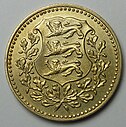This article includes a list of general references, but it lacks sufficient corresponding inline citations. (February 2022) |
You can help expand this article with text translated from the corresponding article in Estonian. (April 2018) Click [show] for important translation instructions.
|
| Eesti mark (Estonian) | |||||
|---|---|---|---|---|---|
| |||||
| Unit | |||||
| Plural | marki (Estonian partitive sg.) | ||||
| Symbol | EEM | ||||
| Denominations | |||||
| Subunit | |||||
| 1⁄100 | penn | ||||
| Plural | |||||
| penn | penni (Estonian partitive sg.) | ||||
| Banknotes | |||||
| Freq. used | 5, 10, 20, 50 penni; 1, 3, 5, 10, 25, 50, 100, 500, 1000, 5000 marki | ||||
| Coins | |||||
| Freq. used | 1, 3, 5, 10 marki | ||||
| Demographics | |||||
| Date of introduction | 30 November 1918 | ||||
| Replaced | German ostmark (ℳ) 1 ℳ = 1 EEM | ||||
| Date of withdrawal | 31 August 1928 | ||||
| Replaced by | Estonian kroon (EEK) 100 EEM = 1 EEK | ||||
| User(s) | None, previously: | ||||
| Issuance | |||||
| Central bank | Bank of Estonia | ||||
| Website | www | ||||
| This infobox shows the latest status before this currency was rendered obsolete. | |||||

The Estonian mark (Estonian: Eesti mark) was the currency of Estonia between 1918 and 1928. It was running parallel with payment notes from the Clearing House of Tallinn as there was lack of cash in Estonia. The last available payment notes were exchanged for marks in 1923. On 11 November 1918 the Estonian Provisional Government assembled after the Armistice to discuss, among other issues, financial questions and on 30 November 1918 the Provisional Government agreed to establish the Estonian mark. The currency was modeled after Germany as Estonian finances were influenced by German law in 1918.[1] It was initially equivalent to the German ostmark, which had been circulating alongside the Imperial rouble since the German occupation. It was divided into 100 penns (in Nominative case: penn).
Until 1919 there were also Russian rubles, German ostrubels and Finnish marks in circulation.
The first marks were printed in Estonia and Finland in different denominations and there were different types. These were released first to public use in spring 1919 by the Bank of Estonia as starting on 30 April 1919, they were the only institution with the right to release bank notes in Estonia. Initially the mark was a cashregister note (Estonian: kassatäht). In 1922 an exchange note (Estonian: vahetustäht) came into circulation that as per regulations, government institutions and agencies were obliged to accept in unlimited quantities and private institutions and persons up to 2000 marks with each payment. Finally, Bank of Estonia bank notes (Estonian: pangatäht) were released that were fully covered by the "bank's assets and pawned assets in the bank's possession".[2]
At the time of the mark's initial introduction, the Estonian government attempted to back the currency up with real collateral but after this failed, the mark became just paper currency without cover. Due to the economical situation, the mark's high inflation and the depletion of gold reserves, the state initiated steps to organize a monetary reform to stabilize the situation. The mark was replaced in 1924 in foreign trade and 1928 in daily use by the Estonian kroon at a rate of 1 kroon = 100 marka. As there had not been enough kroon bank notes printed by 1928, the final series of 100 mark cashregister notes were overprinted with the text "one kroon" (Estonian: ÜKS KROON)[3]
- ^ "History of Estonian money". 7 May 2021.
- ^ "Rahatähtedes peegeldub Eesti ajalugu".
- ^ "History of Estonian money". 7 May 2021.

